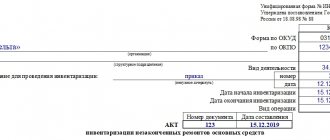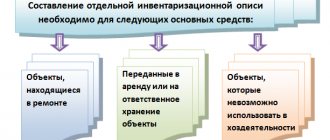The procedure for conducting cash inventory on the territory of Russia is established by Federal Law No. 402-FZ dated December 6, 2011 “On Accounting”, Order of the Ministry of Finance of the Russian Federation dated July 29, 1998 No. 34n “On approval of the Regulations on accounting and financial reporting in the Russian Federation ", Order of the Ministry of Finance of the Russian Federation dated June 13, 1995 No. 49 “On approval of the Methodological Guidelines for the Inventory of Property and Financial Liabilities.”
The purpose of conducting a cash register inventory is to check the correctness and reality of the current accounting of cash transactions, identify errors in calculations, control over the safety of funds and monetary documents in the cash register, and adhere to the principle of financial responsibility of officials.
Frequency and conditions of inventory
Inventory is one of the accounting methods and acts as a tool to confirm the actual availability and accounting data.
You can consider the concept of inventory in more detail within the framework of studying the discipline: “Accounting Theory”, in the article: “Inventory as a method of accounting.” The use of this method has quite ancient roots and is an integral part of accounting for any enterprise.
Historical summary!
The word “inventory” was first mentioned less than a hundred years ago... Read more
Cash inventory, in turn, provides confirmation of the correct execution of cash transactions, helps identify errors and performs a monitoring function over the safety of funds.
The regulatory framework for conducting an inventory is:
- Federal Law “On Accounting” dated December 6, 2011 N 402-FZ
- Order of the Ministry of Finance of Russia dated July 29, 1998 N 34n (as amended on April 11, 2018) “On approval of the Regulations on accounting and financial reporting in the Russian Federation”
- Guidelines for inventory of property and financial obligations, approved by Order of the Ministry of Finance of the Russian Federation dated June 13, 1995 No. 49
According to these regulatory documents, cases of mandatory inventory are established by law:
- property transferred for rent, as well as during the redemption or sale;
- property of a state or municipal organization in case of its transformation;
- annually all property, the inventory of which was carried out before October 1 before the preparation of annual reports, while certain categories have their own characteristics.
- in cases of change of the financially responsible person (on the day of transfer of cases);
- as a result of theft and damage to property;
- in case of emergencies, natural disasters, fires;
- property of the organization subject to liquidation or reorganization;
Data taken from the article: “Inventory as an accounting method.”
In addition, the enterprise has the right to conduct an unscheduled inventory of the cash register. This type of inventory is carried out within the time frame determined by the management of the organization and is reflected in the order to conduct an unscheduled inventory, indicating the reasons for its implementation. Typical reasons for this may include:
- performing a supervisory function, increasing the responsibility of the cashier;
- identifying the causes of errors in accounting;
- as prescribed by external regulatory authorities.
When is an audit carried out at the cash register?
On a scheduled basis, cash checks are carried out in cases regulated by regulations; the duration and procedure for its conduct are fixed in the company’s accounting policies. For example, a cash register inventory is required:
- at the discretion of the manager once in the reporting period and necessarily at the end of the financial year;
- when transferring company assets for rent or sale;
- when changing cashier;
- when identifying abuse, theft, and other emergency situations;
- upon liquidation of the company.
An unscheduled audit is carried out suddenly. It can be initiated by:
- audit apparatus of a higher organization;
- investigative authorities;
- company management to strengthen control functions or when discrepancies in accounting are identified.
Regardless of the status of the inspection, it begins only upon presentation of an order appointing a commission and indicating the reason for the conduct. Both the internal order of the head of the company and the order of the inspection authorities must be correctly drawn up and contain all the necessary information.
Inventory commission: concept, composition, functions
Before carrying out the inventory, the manager approves the order to carry out the inventory. This order determines the name of the property and obligations subject to verification. In addition, this order contains information about the timing, reason, and composition of the inventory commission. The inventory commission signs this order represented by the chairman of the commission and members of the commission, indicating their positions.
Conceptual help!
An inventory commission is a special commission created at an enterprise for the purpose of reconciling accounting data with actual data.
According to clause 2.2 of the Guidelines for the inventory of property and financial obligations, approved by Order of the Ministry of Finance of the Russian Federation dated June 13, 1995 No. 49, the composition of the commission is permanent. However, when the volume of work is large, working commissions may be created. The composition of the inventory commission is determined by an internal administrative document (order).
The personal composition of the commission includes:
- representative of the management level of the organization;
- accounting employee;
- employee of the audit service within the enterprise/representative of an independent audit company;
- employee of the company's security department, etc.
The absence of even one member of the commission is grounds for canceling the inventory results.
In the absence of personnel changes in the composition of the commission, the regulatory framework does not oblige the enterprise to reissue an order fixing its composition.
The key function of the inventory commission is the control function . This function is implemented through a system of main areas to be checked:
- Storing cash in the cash register according to the established limit. This condition is verified by checking the cash balance in the cash register at the end of the day with the limit amount.
- Availability and relevance of concluded agreements with cashiers on full financial responsibility.
- Compliance with the procedure for filling out the cash book and other cash documents.
- Security of cash. If a surplus or shortage is detected, determine the reasons and identify the culprits.
- Correctness of the assigned account assignment for compliance with the distribution by cost items.
- Checking compliance with the deadlines for accepting primary cash documents for accounting, etc.
Each enterprise that carries out cash transactions is obliged to verify the cash register by conducting an inventory.
Inventory procedure, basic rules
The initial stage of the inventory is to suspend the operation of the cash register and provide the commission with the latest primary documents on cash flow. In this case, the person with whom an agreement on full financial responsibility has been concluded (cashier, accountant who is entrusted with the functions of a cashier) is obliged to submit a compiled cash report on the day of the inventory, as well as a receipt that the documents have been submitted to the accounting department or transferred to the commission, all funds received at the cash desk capitalized, and those issued are written off as expenses.
The next step is to check cash, namely a direct recalculation of money at the cash desk in the presence of all members of the commission, as well as the financially responsible person. Cash in the safe (banknotes, coins) and monetary documents are counted. The received amount is checked against the cash balance according to the accounting data (primary documents, accounting program). In addition, if an enterprise makes payments using cash registers, then cash register indicators are subject to mandatory verification.
Basic rules for conducting inventory:
- Ensuring the presence of all commission members approved by order. This condition is mandatory for the inventory results to be recognized as valid.
- Documents compiled during the inventory process are drawn up in at least two copies (matching statements, acts, protocols).
- The financially responsible person must be present during the inventory.
- The documentation drawn up based on the results of the inventory must be signed by all participants of the inventory commission and the financially responsible person.
The inventory act is the final document during the inspection and contains information about accounting and actual data.
Write-off of shortages during inventory
At the same time as writing off the shortage, it is necessary to recover damages from the culprit. The procedure is regulated by stat. 248 TK. It says here that a deficiency of less than the average salary for 1 month can be withheld by order of the director of the company. The issuance of the order must be carried out no later than one month from the date of determination of the final damage.
Otherwise, the shortfall can only be recovered through the courts. The same rule also applies in a situation where an employee refuses to compensate for damage voluntarily. By mutual agreement of the parties (employer and cashier), it is allowed to repay the lack of funds not in a single amount, but in parts, that is, in installments. In this case, it is necessary to stipulate the exact terms of settlements: the employee must provide a written undertaking to pay the missing amounts.
Note! Additionally, disciplinary, administrative and criminal liability may be imposed on the guilty employee.
Registration of inventory results
Registration of inventory results is carried out by generating the following documents:
- “Cash Inventory Act” (Form No. INV-15);
- “Inventory list of securities and forms of strict reporting documents” (Form No. INV-16).
The inventory report, like other documents, is drawn up in two copies. When changing the financially responsible person, in triplicate. One copy is handed over to the accounting department, the second is handed over to the MOL who handed over the value, the third copy is given to the MOL to the one who accepts the value.
A comparison of accounting and actual data when drawing up an inventory report allows us to draw a conclusion about their compliance or the presence of discrepancies. This information is sent to the chief accountant and the head of the organization for further decisions.
The correspondence of actual data with accounting data confirms the high-quality work of the cashier and the correct construction of accounting for cash transactions.
Detection of any deviations (shortages, surpluses) involves finding out the reasons for their occurrence and reflecting these inconsistencies in the inspection report.
conclusions
The main purpose of a cash register audit is to control compliance with cash discipline by responsible employees of the enterprise.
This procedure involves monitoring the correctness of cash accounting and paperwork, identifying possible violations in the field of cash transactions, as well as assessing the quality of work of cashiers, who are financially responsible entities.
An indicative result of such an inventory is considered to be confirmation of compliance or identification of discrepancies between the actual cash balance and cash accounting information.
Detection of surpluses/shortages requires accounting, documentation, and management taking appropriate action.
Typical entries for registering cash register inventory in accounting
Accounting entries according to the act are reflected in account 50
| № | Contents of business transactions | Source documents | Corresponding accounts | |
| Debit | Credit | |||
| 1 | 2 | 3 | 4 | 5 |
| 1 | Excess cash found during inventory at the cash desk was capitalized | Inventory act, inventory list | 50 | 91/1 |
| 2 | During inventory, a shortage of money was discovered in the cash register. | Inventory act, inventory list | 94 | 50 |
| 3 | The amount of the shortfall is attributed to the cashier | Inventory act, inventory list | 73/2 | 94 |
| 4 | The cashier deposited the amount of the shortage into the cash register | PKO | 50 | 73/2 |
| 5 | The amount of the shortfall is withheld from the cashier's salary | Payroll | 70 | 73/2 |
| 6 | The discovered amount of money shortage in the cash register was attributed to other expenses of the enterprise (the culprits were not found) | Inventory act, inventory list | 91/2 | 94 |









